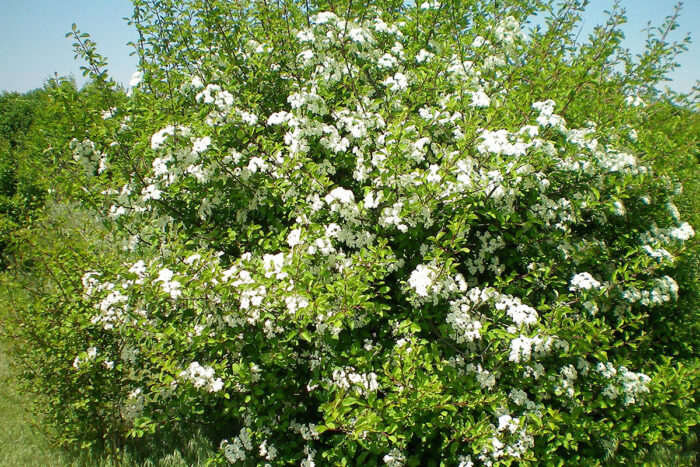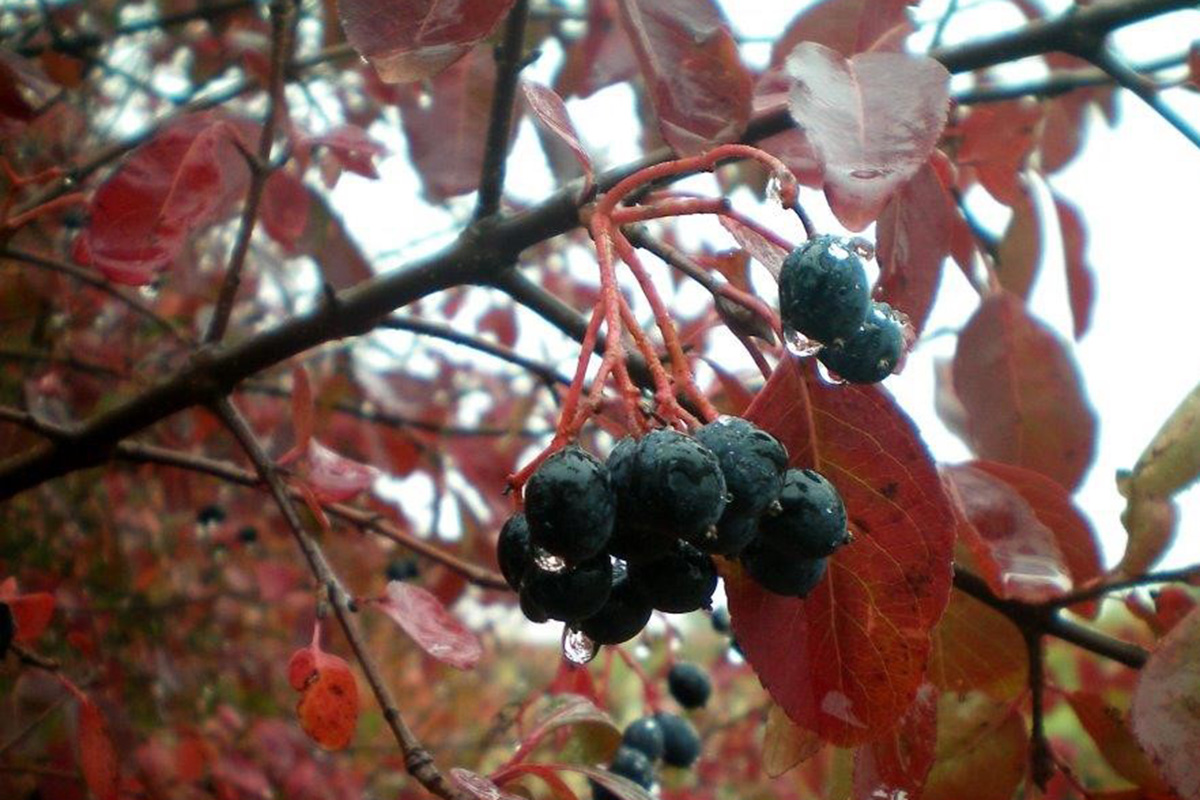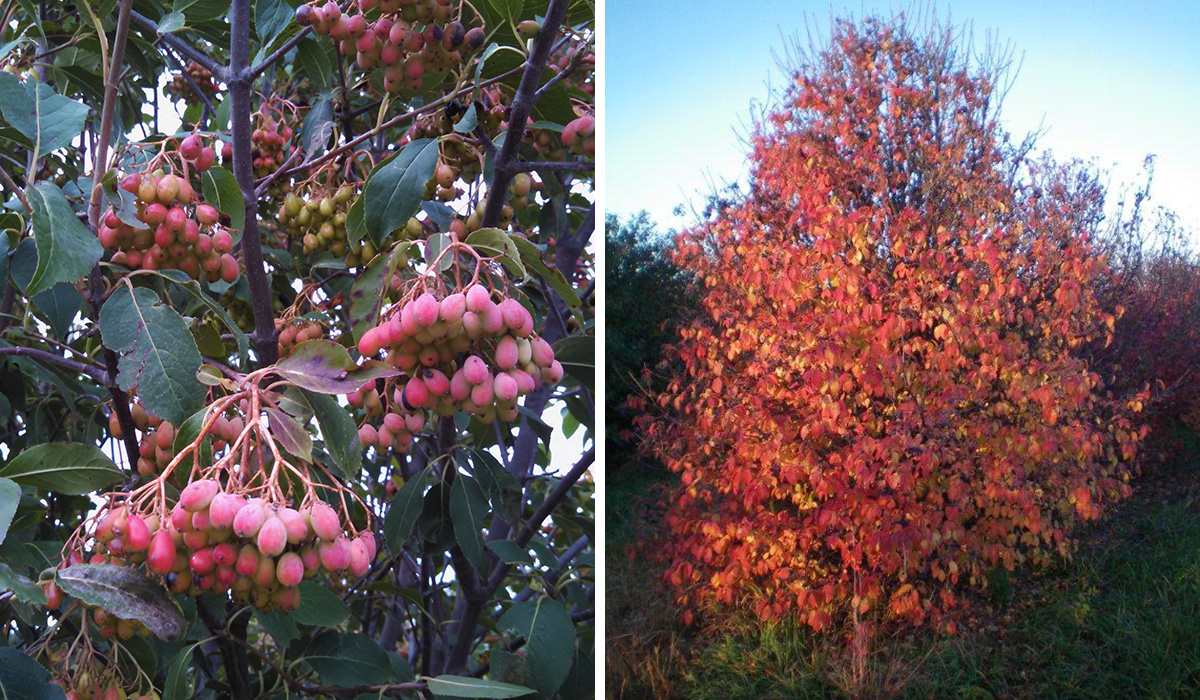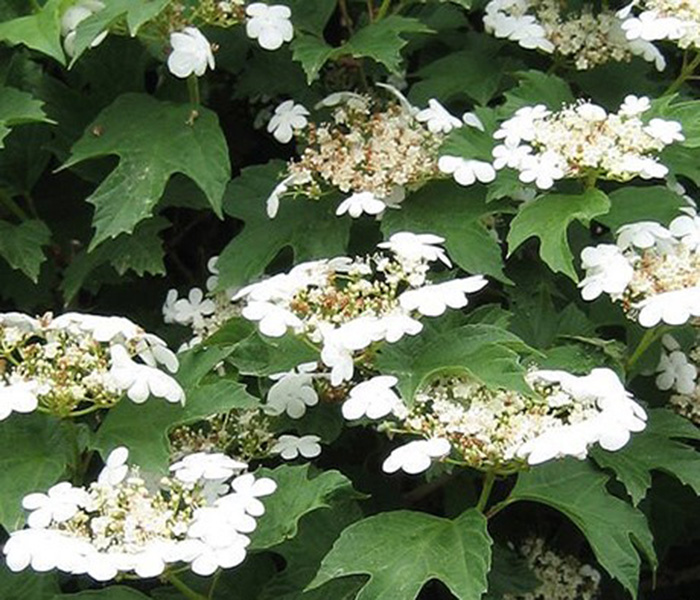
The great plantsman Michael Dirr once said, “A garden without a viburnum is akin to life without music and art.” Viburnums (Viburnum spp. and cvs., Zones 3–9) are a large and diverse group of woody plants, ranging from 12-inch-tall compact shrubs up to 20-foot-tall trees. Some sport deciduous leaves, while others are evergreen; some have fragrant flowers, while others do not; and they all look good planted as specimens or in large groups. There is a viburnum for every garden and every gardener. A recent visit with my friend Gary Ladman of the specialty nursery Classic Viburnums in Upland, Nebraska, led to a healthy debate on which are the best of the less-appreciated viburnums that are appropriate for our climate. The following are a few of our favorite viburnums for the Northern Plains.

Mapleleaf viburnum is a small native shrub that’s perfect for a shady understory
Viburnum acerifolium, Zones 3–8
Native to the eastern half of North America, mapleleaf viburnum is a small deciduous shrub with foliage that resembles—as its name suggests—maple leaves. White, lacey spring and summer flowers turn into bright red fruit by late summer. This fruit then turns a blackish purple as it ripens in fall, signaling to the awaiting birds that it’s ready for consumption. The change in the berries’ color is accompanied by a fall foliage display of creamy pastel pinks, reds, and purples. This plant performs well in the dry shade conditions of a forested understory; it is also tolerant of being grown on a slope. It will reach 4 to 6 feet tall and 3 to 4 feet wide, requiring regular watering until the root system is established. A well-drained, organic, and humus-rich soil will give this remarkable shrub the best start for a long life in the garden.

Blackhaw viburnum has a treelike habit with a dense branching structure
Viburnum prunifolium, Zones 3–9
Blackhaw viburnum is a U.S.-native deciduous shrub that grows upright into a multistem tree form that will reach 12 to 15 feet tall and wide, although very old plants have been known to grow much larger. You can encourage a more treelike habit with selective pruning for a single stem if you start early enough. Blackhaw viburnum’s flowers are flat-topped creamy white cymes with yellow stamens that bloom in spring. The rose-colored fruit that follows ripens to black. It was often used by colonial Americans to make fig-flavored preserves. The dark green summer leaves can have a semi-glossy sheen, but the fall foliage varies from yellow to a fiery orange-red. This viburnum has a very stiff and dense branching structure, creating a perfect sanctuary for birds. The specimen I had outside my kitchen window was the location of a cardinal’s nest for many years, hidden from all but my careful peeks through the maze of branches. Popular and well-performing cultivars of this species include Forest Rouge® (‘McKRouge’), ‘Ovation’, and ‘Summer Magic’. Quite shade tolerant, blackhaw viburnum is a good choice for planting under taller trees.

‘Prairie Classic’ viburnum is a nativar with spectacular fall foliage
Viburnum ‘Prairie Classic’, Zones 4–9
This viburnum is a naturally occurring hybrid. Its parents are thought to be blackhaw viburnum and rusty blackhaw viburnum (Viburnum rufidulum, Zones 5–9). White spring flowers turn into a profuse set of green, egg-shaped fruits. These fruits turn pink, then blue, then black. They remain standing over winter and are devoured the following spring by our feathered friends. This viburnum’s attractive, leathery dark green summer foliage turns into a rainbow of red, green, and yellow leaves in fall. Later in fall the leaves turn a deep maroon with glowing interiors of gold. With heavy, rigid branches and an upright, oval habit, ‘Prairie Classic’ grows 15 feet tall and wide. It can easily be trained as a single-stem small tree or multistem small tree. Otherwise, you can allow it to grow into its natural shrub form. This adaptability makes it an excellent choice for large and small landscapes. ‘Prairie Fire’ was chosen as the 2012 shrub of the year for the Great Plants for the Great Plains program. This program is a joint effort between the Nebraska Statewide Arboretum and the Nebraska Nursery and Landscape Association to highlight the best plants for the Midwest and Plains regions.

‘Spring Green Compact’ highbush cranberry
Viburnum trilobum ‘Spring Green Compact’, Zones 3–7
Highbush cranberry or American cranberrybush is a deciduous shrub that’s native from the American Midwest to the Northeast and into Canada. It normally grows 8 to 12 feet tall and wide, but this compact cultivar grows 5 to 6 feet tall and 3 to 4 feet wide. ‘Prairie Fire’ typically has an upright, oval habit but often matures into a more rounded form. While most compact highbush cranberry varieties display few flowers or fruit, that is not the case with ‘Spring Green Compact’. This cultivar has ample fragrant white flowers in spring that mature to bright orange fruit that remain over winter. The new spring growth displays a reddish tinge and soon becomes light green for summer and orange-red in fall. This plant truly has four seasons of interest. While highbush cranberry can produce fruit on its own, adding another plant for cross-pollination will boost fruit production. ‘Spring Red Compact’ highbush cranberry (Viburnum trilobum ‘Spring Red Compact’, Zones 3–7) is the recommended companion to ‘Spring Green Compact’ for this purpose.
Above are four worthy native and nativar contenders from which you can select a new addition to your garden. Which will it be? Can you choose only one? No matter what you choose, gardeners in the Northern Plains have a large selection of viburnums to choose from for stunning year-round interest.
For more information on viburnums, check out:
- All About Growing Viburnums
- How to Plant a Viburnum
- How to Prune Viburnums and Other Cane-Growing Shrubs
And for more Northern Plains regional reports, click here.
—Marti Neely, FAPLD, owns and operates Marti Neely Design and Associates in Omaha, Nebraska.


















Comments
Log in or create an account to post a comment.
Sign up Log in